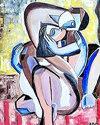记录无言的证词
IF 0.3
4区 社会学
0 HUMANITIES, MULTIDISCIPLINARY
ANGELAKI-JOURNAL OF THE THEORETICAL HUMANITIES
Pub Date : 2023-07-04
DOI:10.1080/0969725X.2023.2233801
引用次数: 0
摘要
摘要本文探讨了让植物作为核事件的见证者发出声音的意义。它考察了两个文本,试图通过文本和图像的混合方法来表现辐照植物的非语言证词:杉原里子的《前往原子弹爆炸树的朝圣》(Hibakuju junrei, 2015)和迈克尔·马德尔和Anaïs Tondeur的《切尔诺贝利植物标本:爆炸意识的碎片》(2016)。出版时间相隔一年,两本书都聚焦于核灾难的来生:1945年的广岛原子弹爆炸和1986年的切尔诺贝利核灾难。杉原的书讲述的是广岛原子弹爆炸后幸存下来的树木,直到今天还在继续生长。这本书结合了地图、照片、采访和短文,旨在成为一本身临其境的指南,介绍广岛原子弹爆炸遗址周围两公里半径内近170棵受辐射的树木。它将这些树木呈现为“活生生的见证人”,它们随后的繁荣为人类幸存者提供了破坏性可塑性的概念形象。Marder和Tondeur的《切尔诺贝利植物标本》在形式上类似于杉原的《被原子弹轰炸的树的朝圣》,同样将文本(简短的理论文章和个人对切尔诺贝利核泄漏的记忆的结合)和图像(Tondeur在禁区种植的植物的照片)结合在一个薄薄的卷中,呼吁拒绝语言作为唯一的见证手段。根据马德尔的说法,托德尔的照片“带来了植物的证词”,然而同样的程序使这些植物证人成为“标本”,充满放射性,但没有生命(杉原的书通过摄影媒介避免了这一点)。切尔诺贝利植物标本馆试图以零碎的形式,捕捉语言在植物生命概念化和切尔诺贝利灾难的适当概念化方面的局限性。最终,这两个文本都是“思考不可想象的,代表不可代表的”的实验,借用马德尔的话,通过对植物学领域的深刻的、思考性的参与。通过人与植物的相互作用,无言的见证得到了表达,植物生命的可塑性(其适应和变化的能力)得到了强调,这使我们能够在这两本自称为“指南”的书中找到植物形态的时刻——将植物的品质归因于人类。本文章由计算机程序翻译,如有差异,请以英文原文为准。
Documenting Wordless Testimony
Abstract This article considers what it means to give plants a voice as witnesses to nuclear events. It examines two texts that attempt to represent the nonverbal testimony of irradiated plants through a hybrid approach of text and image: Sugihara Rieko’s Pilgrimage to the A-Bombed Trees (Hibakuju junrei, 2015) and Michael Marder and Anaïs Tondeur’s The Chernobyl Herbarium: Fragments of an Exploded Consciousness (2016). Published a year apart, both texts focus on the afterlife of nuclear catastrophes: the atomic bombing of Hiroshima in 1945 and the Chernobyl nuclear disaster in 1986. Sugihara’s book is an account of the hibakujumoku – trees that survived the atomic bombing of Hiroshima and continue to produce new growth to this day. Combining maps, photographs, interviews, and short essays, Pilgrimage to the A-Bombed Trees is intended as an immersive guidebook to the nearly 170 irradiated trees located within a two-kilometer radius around Hiroshima’s ground zero. It presents these trees as “living witnesses” whose subsequent flourishing has provided human survivors with a conceptual figuration of destructive plasticity. Marder and Tondeur’s The Chernobyl Herbarium formally resembles Sugihara’s Pilgrimage to the A-Bombed Trees, and likewise combines text (a combination of short theoretical essays and personal remembrances of the Chernobyl meltdown) and images (Tondeur’s photograms of plants grown in the exclusion zone) into a slim volume that calls for a rejection of language as the sole means of bearing witness. According to Marder, Tondeur’s photograms “bring out the testimony of the plant,” and yet the same procedure renders these plant witnesses “specimens,” full of radioactivity but devoid of life (something Sugihara’s book avoids through the medium of photography). The Chernobyl Herbarium is an attempt to capture, in fragmentary form, the limits of language in the conceptualization of plant life and in the proper conceptualization of the Chernobyl disaster. Ultimately, both texts are experiments to “think the unthinkable and represent the unrepresentable,” to borrow Marder’s words, through a deep, speculative engagement with the botanical realm. As wordless testimony is given voice through human–botanical intra-action, the plasticity of plant life (its capacity to adapt and change) is highlighted, and this allows us to locate moments of phytomorphism – the attribution of vegetal qualities to the human – in these two self-proclaimed “guidebooks.”
求助全文
通过发布文献求助,成功后即可免费获取论文全文。
去求助
来源期刊

ANGELAKI-JOURNAL OF THE THEORETICAL HUMANITIES
HUMANITIES, MULTIDISCIPLINARY-
CiteScore
0.60
自引率
33.30%
发文量
57
期刊介绍:
Angelaki: journal of the theoretical humanities was established in September 1993 to provide an international forum for vanguard work in the theoretical humanities. In itself a contentious category, "theoretical humanities" represents the productive nexus of work in the disciplinary fields of literary criticism and theory, philosophy, and cultural studies. The journal is dedicated to the refreshing of intellectual coordinates, and to the challenging and vivifying process of re-thinking. Angelaki: journal of the theoretical humanities encourages a critical engagement with theory in terms of disciplinary development and intellectual and political usefulness, the inquiry into and articulation of culture.
 求助内容:
求助内容: 应助结果提醒方式:
应助结果提醒方式:


